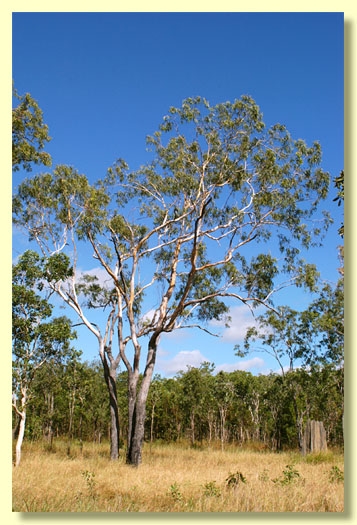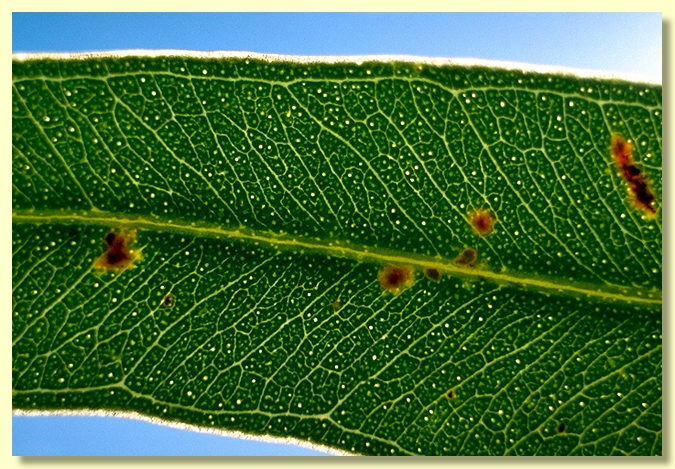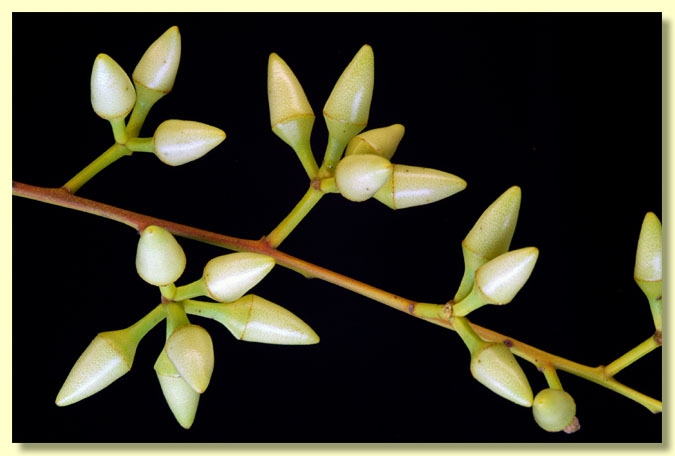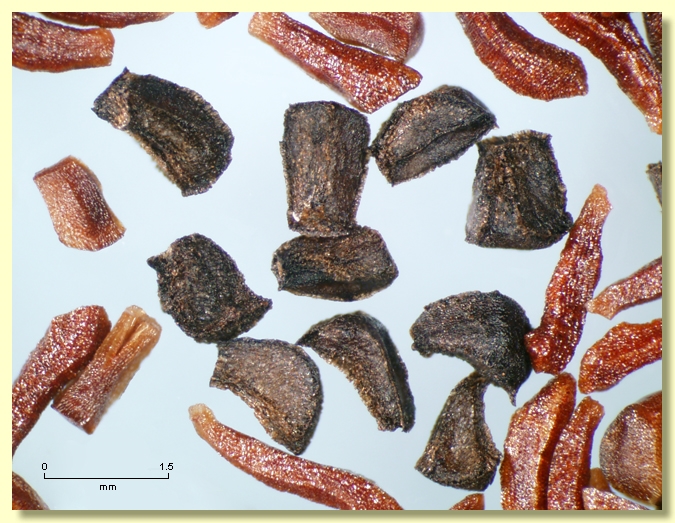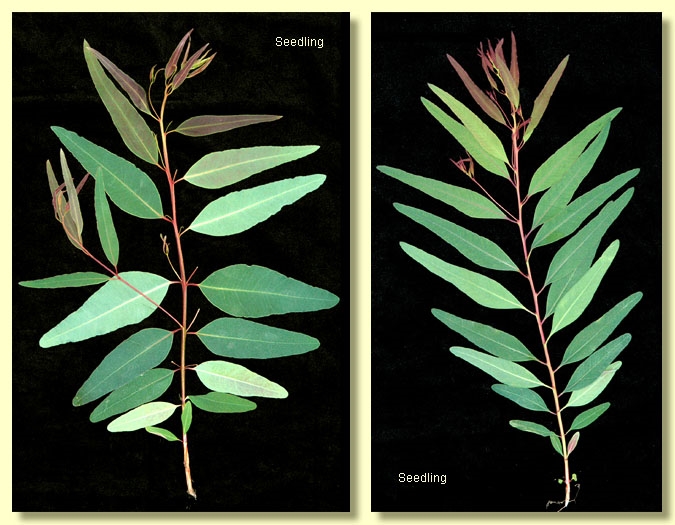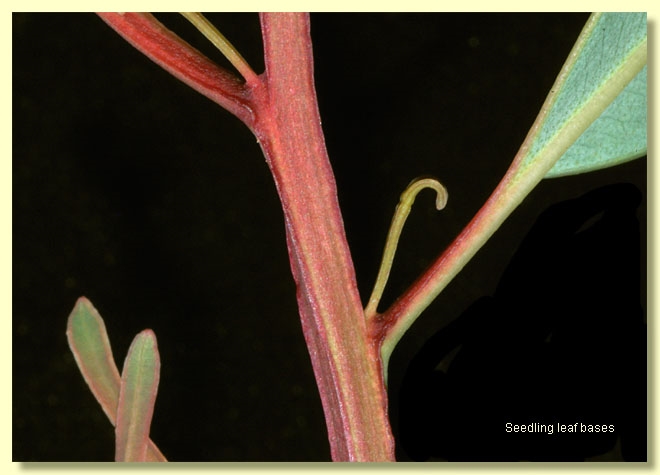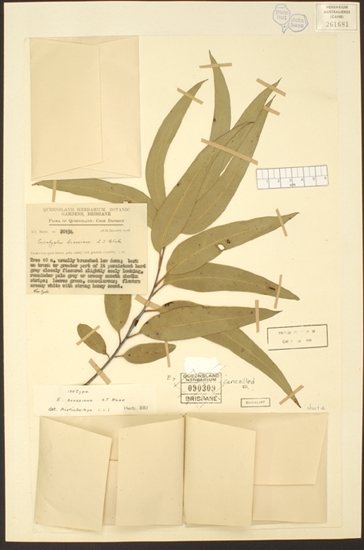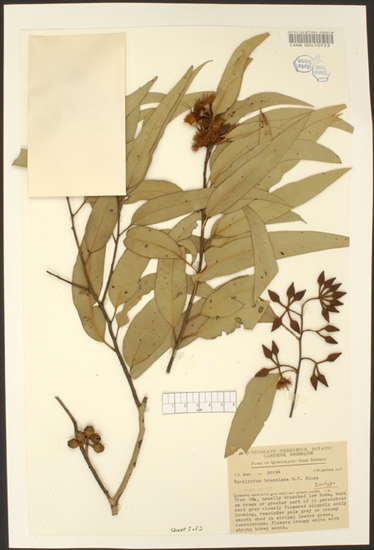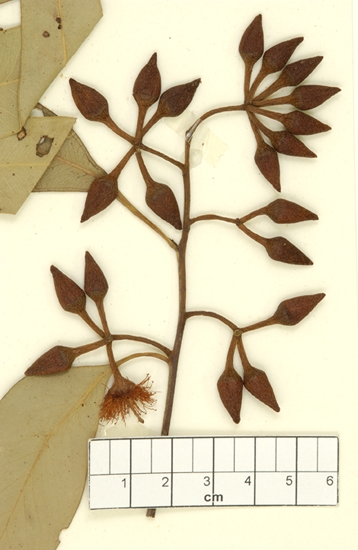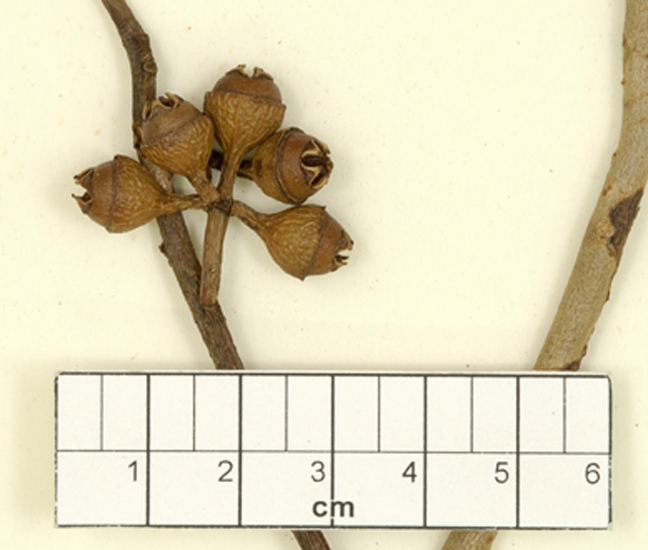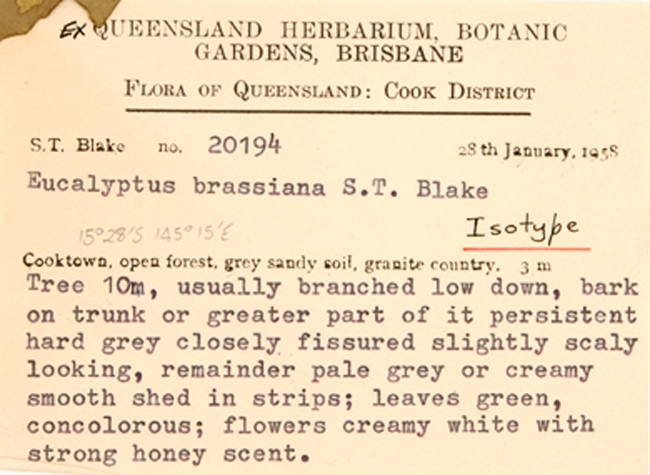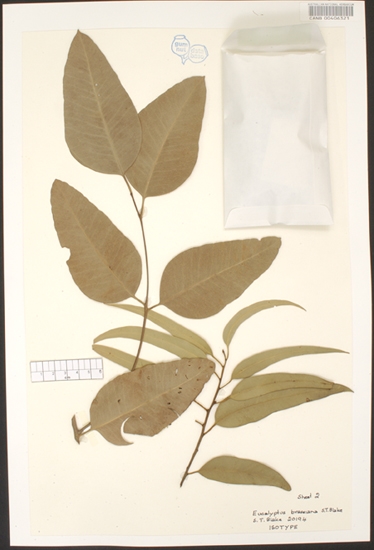Euclid - Online edition
Eucalyptus brassiana
Eucalyptus | Symphyomyrtus | Exsertaria | Phaeoxylon
Tree to 20 m tall. Forming a lignotuber.
Bark rough, usually only on the lower trunk for 2–4 m, sometimes rough to the small branches, often compacted and hard and fissured like that of an ironbark, dark grey to black. Smooth bark grey over white to creamy-yellow to orange.
Juvenile growth (coppice or field seedlings to 50 cm): stem square or rounded in cross-section; juvenile leaves petiolate, opposite for 4 to 7 pairs, then alternate, ovate to broadly lanceolate, 6–21.5 cm long, 3.5–7 cm wide, dull, usually green.
Adult leaves alternate, petiole 1.2–2(2.2) cm long; blade narrowly lanceolate or falcate, 10–22 cm long, 1–2.5(2.8) cm wide, base tapering to petiole, concolorous, glossy, rarely dull, usually green, side-veins acute or at an angle greater than 45° to midrib, moderately reticulate, intramarginal vein parallel to the margin, oil glands island or rarely intersectional.
Inflorescence axillary unbranched, peduncles 1–2.2 cm long, buds 7 per umbel, pedicels 0.6–0.9 cm long. Mature buds ovoid (1–1.5 cm long, 0.4–0.7 cm wide), yellow or creamy, smooth, scar present, operculum conical to horn-shaped (0.8–1 cm long), stamens erect, anthers cuboid to oblong, versatile, dorsifixed, dehiscing by longitudinal slits (non-confluent), style long, stigma tapered, locules 4(5), the placentae each with 6 vertical ovule rows. Flowers white.
Fruit pedicellate (pedicels 0.3–1 cm long), hemispherical or cup-shaped, rarely campanulate, 0.4–1 cm long, 0.7–1.2 cm wide, disc raised steeply, vertical to oblique, valves 4(5), strongly exserted.
Seeds dark brown to black, 1–1.7 mm long, pyramidal or cuboid, dorsal surface pitted, hilum terminal.
Cultivated seedlings (measured at ca node 10): cotyledons reniform to oblong or bilobed; stems square in cross-section, sometimes slightly winged also; leaves always petiolate, opposite for 4 to 8 nodes, becoming alternate, lanceolate to broadly so, 7–18 cm long, 1.5–4.2 cm wide, base tapering, margin often undulate, apex pointed, dull, green, discolorous.
Flowering time unknown.
A small to medium-sized tree of Cape York Peninsula, from the Cooktown–Lakeland Downs area, north along the eastern side of the Cape, then westwards to the Aurukun–Weipa area and then further north through the rest of the Cape to Horn Island in the Torres Strait and beyond into southern Papua New Guinea. A population has been recently discovered in the Bullaringa National Park north-west of Mount Surprise (fide A.R. Bean). Characterised by the rough bark on the trunk, the smooth-barked branches, the buds with a long narrow horn-shaped operculum, fruit with steeply ascending disc and prominently exserted valves and the relatively broad juvenile leaves.
Eucalyptus brassiana belongs to a group of red gums that is distinguished by having rough bark, buds with the stamens mostly erect, fruit where the disc is united to the ovary roof and by the dark brown to black, toothed, cuboid to pyramidal single-coated seed. This group has 6 taxa occurring from central New South Wales north to New Guinea. They are E. brassiana, E. lockyeri subsp. lockyeri, E. lockyeri subsp. exuta, E. ammophila, E. exserta and E. morrisii. Within this group, E. brassiana is closest to E. lockyeri subsp. exuta and E. exserta and can be separated from both by its relatively broad juvenile leaves, (0.3–1.6 cm wide in E. exserta, 0.5–1.6 cm in E. lockyeri subsp. exuta and 3–7 cm wide in E. brassiana) and by its slightly broader fruit (0.4–0.8 cm wide in E. exserta, 0.6–0.8 cm in E. lockyeri subsp. exuta and 0.7–1.2 cm wide in E. brassiana). It can be separated further from E. exserta by its smooth bark on the upper trunk and large branches. (E. exserta is nearly always rough-barked to the small branches.)
E. brassiana can be easily distinguished from E. lockyeri subsp. lockyeri by its non-glaucous adult leaves, buds and fruit (adult leaves, buds and fruit in E. lockyeri subsp. lockyeri always glaucous). E. ammophila is distinguished by its mallee habit (E. brassiana always a tree). E. morrisii is from central New South Wales and can be distinguished by having 3-budded umbels (always seven-budded in E. brassiana).
With its hard compacted rough bark, its smooth-barked branches, its long narrow operculum and its hemispherical to cupular fruit with steeply ascending disc and prominently exserted valves, E. brassiana should not be confused with any other eucalypt growing within its area of occurrence.
Eucalyptus brassiana: after Leonard John Brass (1900–1971). Len Brass was a noted plant collector and botanist. He was awarded an honorary degree from the Florida State University, Tallahassee in 1962. The university recognised his 35 years of exploration, which produced numerous genera and species new to science. He began his initial botanical training at the Queensland Herbarium 1918–19. Apart from collecting extensively on Cape York in tropical Queensland, he also participated in many plant collecting expeditions to New Guinea, the Solomon Islands and tropical Africa.

